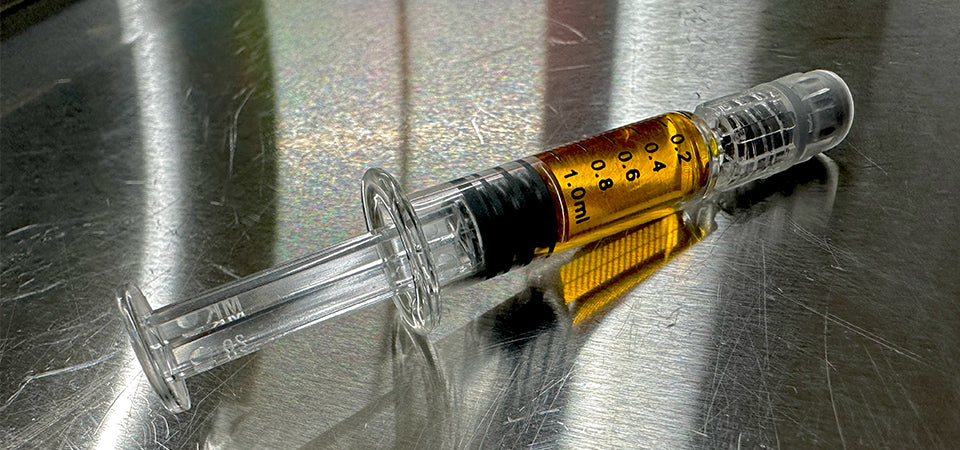How to Decarb Rosin for the Best Potency and Quality

You have to decarb rosin to create top-notch edibles that are rich in valuable terpenes and cannabinoids. When you “decarb” or decarboxylate rosin, you expose it to heat for a certain amount of time to convert THCa and CBDa into its acidic forms (THC and CBD) which unlocks their psychoactive effects.
To decarboxylate the cannabinoids in rosin without degrading the terpenes and cannabinoids, you’ll need to keep your extract at 220°F to 250°F for 25 to 30 minutes (and sometimes more). For maximum terpene preservation, it's advised to stay near the lower end of the range, as some terpenes start to degrade at around 100°F.
Top tip for commercial growers and extractors: If you’re a commercial operator with popcorn buds, trim, or solventless rosin chips, you can use this process to turn these by-products into valuable SKUs. If using popcorn buds or trim to make food-grade rosin, you can either wash them in ice water to make bubble hash or sieve them (when dry) to get dry sift. After you’ve pressed the dried bubble hash or dry sift to extract the rosin, you can then follow the process that we outline here.
How to Decarb Rosin
The best edibles in the world are created with rosin due to the full spectrum cannabinoid and terpene profile available in the product. Where distillate edibles fall short for some users, rosin edibles come in and smack ‘em in the face! It’s also an extremely easy process. You can use this method in a commercial operation or at home and it works fine for both small and large batches.
- Preheat the oven to 220°F, which is our maximum recommended rosin press temperature.
- Put the rosin in a sealable heat-proof glass container. Don’t use an open container because you could off-gas the terpenes.
- Put the glass container on a sheet of parchment paper on a baking tray and put it in the preheated oven. Set a timer for 25 to 30 minutes.
- Every 10 to 15 minutes, stir the rosin and check to see whether it's still bubbling. When the decarboxylation process is complete, the rosin will stop bubbling.
- When the decarbing process is complete, take the rosin out of the oven and allow it to cool.
How to Decarb Rosin Chips in Oil
Rosin chips are the pucks or bricks that are left in your rosin press after the oils have been squeezed out of the bubble hash, dry sift, or flower.
While the best stuff will already have been extracted, rosin chips still contain cannabinoids and terpenes that can be infused into an oil—using either a crockpot or oven—and used to make edibles.
To decarb rosin chips in a crockpot:
- Set the crockpot to "high.”
- Pour your chosen oil into the preheated crockpot. Coconut oil works great.
- Add the rosin chips to the oil. There’s no need to remove them from the bags.
- Leave for 8 hours, stirring occasionally.
- After 8 hours, remove the rosin chips from the oil.
- Strain the infused oil into heat-proof glass jars through cheesecloth to remove any plant material. If you used coconut oil, you can pour the infused coconut oil back into the same jars you got the coconut oil from.
- Once the oil is cool enough, cap the jars and put them in the refrigerator.
Tips for Getting the Best Results when Decarbing Rosin
For a successful decarb process, it helps to get your parameters right when pressing rosin in the first instance.
Pressing Temperature
Use the lowest effective temperature for the rosin extraction process so that your rosin is more malleable and not too dry. If your goal is a badder or budder consistency, try cold pressing between 140°F and 180°F. For a shatter consistency, press between 180°F and 200°F—definitely no higher than 220°F. In general, you'll use lower temperatures when pressing hash rosin and slightly higher temperatures when making solventless extracts from cannabis flower or low-quality dry sift.
Time
For cold pressing, aim to press for 1 to 5 minutes. For hot pressing, pressing times will be shorter—generally 45 seconds to 1 minute. Pressing for the right amount of time ensures that your rosin is as pure as possible and doesn't include things like chlorophyll and plant lipids.
Choice of Oil
Once you've got high-quality rosin, the choice of oil for decarbing your rosin chips also makes a difference—especially if you're making edibles commercially. In a 2020 study, terpenes decreased in olive oil infusions after 15 and 30 days, whereas the terpenes in MCT oil (medium-chain triglycerides) formulations remained stable throughout the entire 90-day storage period. If you're making the infused oil for home use though, you should be fine using common household oils like olive oil, avocado oil, coconut oil, or melted butter.
Applications for Decarbed Rosin
After rosin decarboxylation, you can use a special machine to infuse the rosin with oil or butter to make edibles like gummies. Infused oil made from rosin chips can be combined with butter to make cannabutter (depending on the oil you used) or added directly to recipes that call for infused oil.
Whether you use rosin or infused oil from rosin chips, be careful to calculate your dosages accurately. One gram of rosin can contain up to around 800 mg of THC, so an eighth of a gram of rosin in a recipe that produces 10 servings will give you around 10 mg of THC per piece.
It can be difficult to calculate the THC levels in oil infused with rosin chips, but you can use the flower’s original THC percentage as a starting point and presume that the percentage in the rosin chips is lower. Ideally, have the infused oil tested in a lab or just keep it for personal use.
Clean, Potent, and Powerfully Psychoactive
Cannabis rosin is a potent product in and of itself, and once you've converted the raw form of THC (THCa) into the usable form (THC), you can go ahead and use it to make edibles that produce a zinger high.
When decarbing rosin in an extraction facility or at home, remember:
- Start with quality hash rosin chips, sift rosin chips, or flower and an optimized pressing process. Quality in = quality out.
- Use temperature gauges to make sure your oven or crockpot is at the right temperature throughout the decarbing process.
- Make sure that your rosin has stopped bubbling before removing it from the oven.
- Calculate the THC content of edibles carefully.
Get those things right, and you're set to make some amazing rosin edibles!



